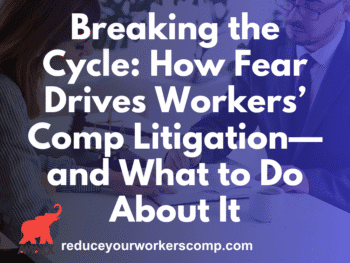Employers who have experienced a long string of seemingly exaggerated claims with anomalously long and expensive periods of disability learn, the hard way, to recognize patterns. First, the names of the doctors are repetitive. Second, the same attorneys always seem to have the claims.
The associations are not pure coincidence. The clustering of certain lawyers and certain doctors is associated with production of work comp claims in a bulk process. Litigation, one claim at a time before the comp board, is seldom productive. In fact, if it were the assembly line of claims would soon come to a halt.
There is a Remedy – Subrogation
An employer, or its carrier, can take over a worker’s right to sue a third party in a procedure known as “subrogation.” Usually, this remedy is found in motor vehicle accidents where the comp carrier sues the other vehicle when the employee has little interest, since much or all of the recovery is paid to the comp carrier, which has a lien.
What is less known is the employer can sue the worker’s doctor for medical malpractice that made a comp injury worse, even if the worker refuses to sue. Provisions for how this is done are contained in Sect. 29 of the New York Workers’ Compensation Law. Persons looking for quick answers are cautioned that this section is not light reading.
Such suits are very rare, but they do occur, among the first being “Parchefsky v. Kroll,” in 1935.
However, for many the largest surprise is that such suits can be brought, by the employer, for legal malpractice against the employee’s comp attorney where the handling of the claim resulted in disability created solely to enhance the value of a claim.
Such suits are not reported because the mere threat of such a suit being underway causes a claim mill to collapse. Doctors, lawyers, and comp boards have marvelous ways of making the abuses vanish when an employer draws a line in the sand and demands that formal courts and attorneys general get involved. It becomes a battle fought, in the words Winston Churchill used to describe covert operations, “in the shadows, in the alleys and in the sewers.” (workersxzcompxzkit)
Such a conflict was fought in New York, in the period beginning in 1993, when anti-fraud units began to take work comp fraud seriously. For every case published, a hundred settled quickly and quietly. For every lawyer and doctor who ran into serious legal problems, dozens opted for a quick change in career goals.
Vigilance, however, must be ongoing. It is the suspicions and the evidence, first provided by employers, that makes the effort worthwhile.
Author: Attorney Theodore Ronca is a practicing lawyer from Aquebogue, NY. He is a frequent writer and speaker, and has represented employers in the areas of workers’ compensation, Social Security disability, employee disability plans, and subrogation for over 30 years. Attorney Ronca can be reached at 631-722-2100.
“FRAUD PREVENTION” PODCAST click here: http://www.workerscompkit.com/gallagher/mp3
By: Private investigator with 25 years experience.
TD Calculator: www.ReduceYourWorkersComp.com/transitional-duty-cost-calculator.php
WC Calculator: http://www.reduceyourworkerscomp.com/calculator.php
Do not use this information without independent verification. All state laws vary. You should consult with your insurance broker or agent about workers’ comp issues.
©2009 Amaxx Risk Solutions, Inc. All rights reserved under International Copyright Law. If you would like permission to reprint this material, contact Info@WorkersCompKit.com
















